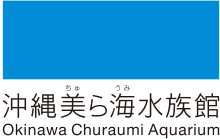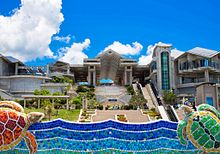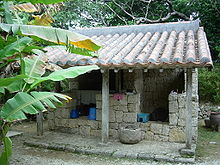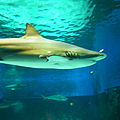bio.wikisort.org - Zoo
The Okinawa Churaumi Aquarium (沖縄美ら海水族館, Okinawa Churaumi Suizokukan), formerly known as the Okinawa Ocean Expo Aquarium, is located within the Ocean Expo Park in Okinawa, Japan. It is a member of the Japanese Association of Zoos and Aquariums (JAZA), and was the largest aquarium in the world until it was surpassed by the Georgia Aquarium in 2005. The aquarium has the exhibit, “Encounter the Okinawan Sea”,[7] which reproduces the sea of Okinawa and most of the creatures that live in it.[2] Churaumi was selected as the name of the aquarium by public vote amongst Japanese people: chura means "beautiful" or "graceful" in the Okinawan language, and umi means "ocean" in Japanese.
 | |
 Entrance
 | |
| Date opened | 1 November 2002 [1] |
|---|---|
| Location | Motobu, Okinawa, Japan |
| Coordinates | 26°41′40″N 127°52′41″E |
| Land area | 19,000 m2 (200,000 sq ft) [1] |
| No. of animals | 11,000[2] |
| No. of species | 720[2] |
| Volume of largest tank | 7,500,000 litres (1,981,000 US gal) [3] |
| Total volume of tanks | 10,000,000 litres (2,642,000 US gal)[4] |
| Annual visitors | 3.5 million + [5][1] |
| Memberships | JAZA[6] |
| Major exhibits | The Kuroshio Sea tank Shark Research Lab Okichan Theater |
| Management | Okinawa Churashima Foundation |
| Website | churaumi |
History

Expo '75 was held in Okinawa, Japan, at the Ocean Expo Park, where an aquarium centered on marine life was displayed. In 1976, the Okinawa Ocean Expo Aquarium was established as a national park on the site of the venue.
The Okinawa Ocean Expo Aquarium and the Okichan Theater started operations with the facilities used at the Expo. At that time, the largest main tank in the aquarium had a water volume of 1,100,000 litres (291,000 US gal), which was the largest in the world.[8]
The Okinawa Ocean Expo Aquarium is one of the first public aquariums in the world that breeds large sharks and rays such as whale sharks and manta rays.[8] At a symposium held in Baltimore in 1985, the Okinawa Ocean Expo Aquarium was rated to have the most advanced breeding technology in the world for long-term rearing.[8] In 1988, the aquarium won the first Koga Award from JAZA in Japan for breeding two generations of whitetip reef sharks.[9]
As the park lost incoming tourists, it was believed that a new aquarium would help revive the area and celebrate Okinawa's marine tradition. In addition, since the facility was built for a short-term expo, it deteriorated significantly, and a plan to build a new aquarium was proposed.[4]
The Okinawa Ocean Expo Aquarium was closed in August 2002 due to facility deterioration, and the Okinawa Churaumi Aquarium was opened on 1 November 2002, with a new facility designed by Yukifusa Kokuba. The number of visitors in the year before the old aquarium closed was about 430,000, but the number of visitors in the year after the opening of the new building increased to 2.75 million.[10] The number of visitors has continued to increase, with the number of visitors reaching 3,784,132 in 2017 and the cumulative number of visitors reaching 50 million in 2019.[5]
In 2020, the number of tourists in Okinawa Prefecture decreased significantly due to the COVID-19 pandemic.[11]
Aquarium
The public aquarium is a part of the Ocean Expo Park located in Motobu, Okinawa. The aquarium is made up of four floors, with tanks containing deep sea creatures, sharks, coral, and tropical fish. The aquarium is set on 19,000 m2 of land, with a total of 77 tanks containing 10,000 m3 of water. Water for the saltwater exhibits is pumped into the aquarium from a source 350 m offshore, 24 hours a day.[12]
The Kuroshio Sea
The main tank, called the Kuroshio Sea, is 35 metres (115 ft) long, 27 metres (89 ft) wide and 10 metres (33 ft) deep.[13] It holds 7,500,000 litres (1,981,000 US gal) of water and features an acrylic glass panel measuring 8.2 by 22.5 metres (27 by 74 ft) with a thickness of 60 centimetres (2 ft),[14] the largest such panel in the world when the aquarium was opened.[3][15]
Whale sharks and manta rays are kept alongside many other fish species in the main tank.[3] Since 2015, the aquarium has also had a reef manta ray with a black body.[16] Since 2018 they also keep giant oceanic manta ray.[17] The world's first birth of a manta ray in captivity was at the aquarium in 2007. This species and the giant oceanic manta ray were only recognized as separate species in 2009; they were both classified as Manta birostris until then.[18][19][20] By the time the mother died in 2013, seven puppies were born and four survived.[21][22][23][24] There is a record that the male reef manta ray, which lived in captivity in 1992, lived for about 23 years.[25]
The first attempt of keeping whale sharks in an aquarium was in 1980, and it remains one of the few aquariums that maintains the species.[26] Most were obtained from incidental catches in coastal nets set by fishers (none after 2009), but two were strandings. Several of these were already weak from capture or stranding and some were released,[26] but initial survival rates were low.[27] After the initial difficulties in maintaining the species had been resolved, some have survived long-term in captivity. The record for a whale shark in captivity is an individual that, as of 2021, has lived for more than 26 years in the Okinawa Churaumi Aquarium from Okinawa Ocean Expo Aquarium.[28]
Okinawa Churaumi is trying to breed whale sharks in captivity, which has never been achieved by an aquarium. Their oldest male reached sexual maturity around 2012 and began to show an interest in females in 2014. The exhibited until 2021 female was on display[29] (another is maintained away from the public) is 8 m (26 ft) long.[30] There were three whale sharks, but they have been moved to a separate tank to make room for breeding.[31] In 2021, a 13-year-old female whale shark that had been in captivity in the Kuroshio Sea tank was transferred to a medical treatment tank in the sea due to poor health, and later died. The cause of death is thought to be feeding difficulties from skeletal abnormalities in the jaw and a twisted pylorus.[32][29]
The Coral Sea
In the Coral Sea tank, 450 colonies of reef-building corals of about 80 species are bred and exhibited.[33] The tank has a capacity of 300,000 litres (79,000 US gal), no roof, a structure that allows strong sunlight to enter, and a constant supply of fresh seawater to enable large-scale breeding of coral. The Coral Sea tank is made to emulate the coral reefs in Motobu.[33] In 2021, the Okinawa Churaumi Aquarium was temporarily closed due to the COVID-19 pandemic, but it was confirmed that Acropora microphthalma gave spawned in the daytime for the first time.[34]
The Shark Research Lab
Sharks such as bull sharks, tiger sharks, silvertip sharks, and silky sharks are bred in the shark research lab tank. Some bull sharks kept in aquariums have lived for more than 42 years.[28]
In 2016, the aquarium showed an attempt to raise an adult great white shark. The great white shark exhibit was successful, but it died three days later, leading to criticism from animal rights groups.[35] In 2019, aquariums captured a pregnant tiger shark and succeeded in giving birth in a shark research lab tank.[36]
Okichan Theater and Dolphin Lagoon

Near the aquarium is the Dolphin Show Stadium, called the Okichan Theater, where viewers can touch the animals and watch the show's performance for free.[37] There is also a dolphin contact facility called Dolphin Lagoon, which houses several species of dolphin.[38][39] The Indo-Pacific bottlenose dolphin named Okichan has been owned since the opening of the Okinawa Ocean Expo Aquarium and has been bred for 45 years as of 2020.[28]
In 2003, the bottlenose dolphin named Fuji's caudal fin was 75% necrotic and had to be resected. The aquarium collaborated with Bridgestone to develop the world's first artificial caudal fin to attach to Fuji.[40][41][42] Fuji died of infectious hepatitis in 2014 at an estimated age of 45.[43]
Other activities

There is a manatee exhibition featuring manatees given to the aquarium by the Mexican government and a sea turtle exhibition.[44][45] A spawning ground dedicated to sea turtles is set up in the exhibition facility.[46] West Indian manatees have also given birth in the facility.[47]
Research and conservation

At the Churaumi Aquarium, the Okinawa Churashima Foundation supervises conservation activities and conducts animal research.[9] The aquarium has won the breeding award from JAZA for 26 kinds of animals, such as the reef manta ray and Indo-Pacific bottlenose dolphin.[9] In particular, it is characterized by the large breeding of large sharks and rays, which are rare in other locations.
The Churaumi Aquarium collects blood from wild whale sharks, measures the total length and circumference of the body, collects tissues for DNA analysis and chemical analysis, and observes behavior in the natural sea using electronic labels[9] to obtain important information on the breeding habits and ecology of whale sharks. It also conducts tests for future breeding, such as monitoring the behavior of whale sharks during breeding and the concentration of hormones in the blood obtained by blood sampling.[9]
The aquarium is conducting research on the diversity of marine life found around Okinawa, and is engaged in activities that contribute to the conservation and sustainable use of the natural environment.[48]
The aquarium is investigating many humpback whales with local people and domestic and foreign researchers.[49] In a joint study with the Philippines in 2021, it was revealed that 43.48% of the humpback whales around the Philippines were the same as the individuals confirmed in Okinawa and were moving between the two waters,[50] revealing the migration route of humpback whales between Okinawa and the Philippines from the previously unknown Russia feeding ground.[50]
As a research institute, the public aquarium contributes to the discovery of new species of marine life. New species discovered in the past include Eumunida balteipes,[51] Hexagonaloides bathyalis,[52] and Synactinernus churaumi, a new species of sea anemone that has been studied for over 15 years.[53]
Gallery
Exterior
Aquarium
Main tank aquarium
Okichan Theater
Sea turtle and manatees
See also
- Tropical & Subtropical Arboretum
References
- "Comparison of major aquariums in the Greater Tokyo Area (Japanese)" (PDF).
- "よくある質問 どのくらいの数の生き物を飼っていますか?". 沖縄美ら海水族館. Retrieved 7 May 2021.
- "Amazing Engineering: the Okinawa Churaumi Aquarium". wayfaring.info. Wayfaring Travel Guide. 21 June 2007. Archived from the original on 9 July 2010. Retrieved 3 August 2010.
- "施設概要 沖縄美ら海水族館". 沖縄美ら海水族館. Retrieved 7 May 2021.
- 国営沖縄記念公園事務所-利用者状況 内閣府沖縄総合事務局 2021-05-07
- "正会員名簿 水族館 / 動物園と水族館" [Member List - Aquarium April 30 3rd year Reiwa 2021]. Japanese Association of Zoos and Aquariums (in Japanese). 1 November 2021. Archived from the original on 1 November 2021. Retrieved 1 November 2021.
- "About Okinawa Churaumi Aquarium - Okinawa Travel Guide | Planetyze". Planetyze. Retrieved 15 August 2017.
- 内田詮三 (2012). 沖縄美ら海水族館が日本一になった理由. 光文社新書.
- "Breeding in Captivity". Retrieved 22 May 2021.
- 1.沖縄ブロックの現状と課題 2021-05-07
- "沖縄美ら海水族館、開業以来初のマイナス収支 県に移管した7施設 4264万円の赤字". 沖縄タイムス. 20 October 2020. Retrieved 7 May 2021.
- "Okinawa Churaumi Aquarium". oki-churaumi.jp. Okinawa Churaumi Aquarium. Archived from the original on 22 June 2013. Retrieved 3 August 2010.
- "Okinawa Churaumi Aquarium | the Kuroshio Sea". Archived from the original on 11 September 2015. Retrieved 29 September 2013.
- "Welcome to Okinawa Churaumi Aquarium". oki-churaumi.jp. Okinawa Churaumi Aquarium. Retrieved 3 August 2010.
- The size of this panel was surpassed in 2008 when a larger panel was installed in the Dubai Mall Aquarium
- "日本初!『ブラックマンタ』展示開始!". 21 December 2015. Retrieved 17 April 2021.
- "The world's largest ray! The giant manta!". Okinawa Churaumi Aquarium. 4 January 2019. Archived from the original on 6 January 2019. Retrieved 5 January 2019.
- "3 Years in a row! This year too, a baby Manta was born in the Oki". oki-churaumi.jp. Okinawa Churaumi Aquarium. 6 July 2010. Archived from the original on 22 July 2011. Retrieved 3 August 2010.
- Marshall, A. D.; Compagno, L. J. V.; Bennett, M. B. (2009). "Redescription of the genus Manta with resurrection of Manta alfredi (Krefft, 1868) (Chondrichthyes; Myliobatoidei; Mobulidae)". Zootaxa. 2301: 1–28. doi:10.11646/zootaxa.2301.1.1. ISSN 1175-5326. S2CID 81789023.
- Ryo Nozu; Kiyomi Murakumo; Rui Matsumoto; Yosuke Matsumoto; Nagisa Yano; Masaru Nakamura; Makio Yanagisawa; Keiichi Ueda; Keiichi Sato (2017). "High-resolution monitoring from birth to sexual maturity of a male reef manta ray, Mobula alfredi, held in captivity for 7 years: changes in external morphology, behavior, and steroid hormones levels". BMC Zoology. 2 (14). doi:10.1186/s40850-017-0023-0.
- "We have just recently had our 4th successful manta ray (Manta birostris) birth in captivity at Okinawa Churaumi Aquarium". oki-churaumi.jp. Okinawa Churaumi Aquarium. 6 July 2010. Archived from the original on 22 July 2011. Retrieved 3 August 2010.
- "平成22-23年度 沖縄美ら海水族館年報" (PDF). Okinawa Churaumi aquarium. Retrieved 29 May 2021.
- "平成24年度 沖縄美ら海水族館年報" (PDF). Okinawa Churaumi aquarium. Retrieved 29 May 2021.
- "平成25年度 沖縄美ら海水族館年報" (PDF). Okinawa Churaumi aquarium. Retrieved 29 May 2021.
- "平成26年度 沖縄美ら海水族館年報" (PDF). Okinawa Churaumi aquarium. Retrieved 29 May 2021.
- Matsumoto; Toda; Matsumoto; Ueda; Nakazato; Sato; and Uchida (2017). Smith; Warmolts; Thoney; Hueter; Murray; Ezcurra (eds.). Notes on Husbandry of Whale Sharks, Rhincodon typus, in Aquaria. Elasmobranch Husbandry Manual II. Special Publication of the Ohio Biological Survey. pp. 15–22. ISBN 978-0-86727-166-9.
{{cite book}}: CS1 maint: uses authors parameter (link) - Goodman, Brenda (14 June 2007). "Georgia Aquarium Mourns Another of Its Whale Sharks". The New York Times. Retrieved 29 December 2018.
- "令和二年度 沖縄美ら海水族館 年報" (PDF). Okinawa Churaumi Aquarium. Retrieved 28 May 2021.
- "美ら海水族館のジンベエザメ死ぬ 沖縄タイムス".
- "Breeding in Captivity". Okinawa Churaumi Aquarium. Retrieved 29 December 2018.
- "水族館の新しいこころみ!ジンベエザメの繁殖に向けた飼育展示について".
- "Whale sharks in the Kuroshio Sea tank".
- "The Coral Sea". Okinawa churaumi aquarium.
- "【動画あり】展示用サンゴで国内初 昼の産卵に美ら海水族館が成功 ピンクの粒が幻想的に舞い上がる". Okinawa times. Retrieved 28 May 2021.
- "Great white shark dies after three days in captivity in Japan". The Guardian. 8 January 2016. Retrieved 6 February 2019.
- "World's first! Tiger shark born in the aquarium.Exhibited now at the Shark Research Lab tank". 1 July 2019. Retrieved 17 April 2021.
- "Dolphin Show (Okichan Theater)". Okinawa churaumi aquarium. Retrieved 22 May 2021.
- "オキちゃん劇場/イルカショー". Okinawa churaumi aquarium. Retrieved 22 May 2021.
- "Pygmy killer whale". Churaumi Official Fish Encyclopedia. Retrieved 22 May 2021.
- "A new beginning for Fuji the dolphin". 15 September 2007. Retrieved 17 April 2021.
- "Fuji, the Bionic Dolphin With the Artificial Fin (video)". 26 December 2010. Retrieved 17 April 2021.
- "Fuji The Dolphin's Rubber Tail". CBS News. 14 December 2004. Retrieved 17 April 2021.
- "Aged dolphin with artificial tail fin dies at Okinawa aquarium". Retrieved 22 May 2021.
- "マナティー館". Retrieved 23 April 2021.
- "Sea Turtle Pool". Retrieved 23 April 2021.
- "The only place in the world exhibiting four different species of baby sea turtles!". Retrieved 23 April 2021.
- "Dolphin Feeding Program / Turtle Feeding Program / Manatee Feeding Program". Okinawa churaumi aquarium.
- "Research publication and activity". Retrieved 22 May 2021.
- "Surveys of the humpback whale Research on marine organisms". Retrieved 7 June 2021.
- "Interchange and movements of humpback whales (Megaptera novaeangliae) between western North Pacific winter breeding grounds in northern Luzon, Philippines and Okinawa, Japan". Retrieved 7 June 2021.
- "新種発見! 世界初「シマツノコシオリエビ」の展示を開始". Retrieved 7 May 2021.
- "美ら海生き物図鑑 シンカイサンゴガニ". Retrieved 22 May 2021.
- "新種発見!世界初「チュラウミカワリギンチャク」の展示を開始". Retrieved 7 May 2021.
External links
- Official website (Japanese)
- Official website (English)
- Churaumi Official Fish Encyclopedia(Japanese)
- Churaumi Official Fish Encyclopedia(English)
- Ocean Park Homepage in English
- Okinawa Churaumi Aquarium's channel on YouTube
- Okinawa Churaumi Aquarium on Facebook
- Okinawa Churaumi Aquarium on Twitter
- Okinawa Churaumi Aquarium on Instagram
- Bus Timetable from Asahibashi Sta. to the Aquarium
 Geographic data related to Okinawa Churaumi Aquarium at OpenStreetMap
Geographic data related to Okinawa Churaumi Aquarium at OpenStreetMap
Другой контент может иметь иную лицензию. Перед использованием материалов сайта WikiSort.org внимательно изучите правила лицензирования конкретных элементов наполнения сайта.
WikiSort.org - проект по пересортировке и дополнению контента Википедии

























